This item is being increased recently, leading to a reduction of profit for farmers. In order to improve the profit of tra catfish farming, feed cost should be reduced. One of the measures to reduce feed cost is through feed additives which improve nutrient absorption and utilization.
Sangrovit® is an all-natural feed additive that has been utilized in many animal species. The main active ingredients of Sangrovit® include bitter constituents, which help to enhance the absorption of feed and promote digestion. The special active substances included in Sangrovit®, belonging to the group of Benzophenanthridine and Protopine Alkaloids, have the additional effects of improving hormonal and chemostatic regulating mechanisms in feed uptake, nutrient absorption and availability. Therefore, it is feasible to utilize its characteristics in tra catfish intensive culture system in Viet Nam.
The purpose of this study was to evaluate the effects of Sangrovit® on the final mean weight, FCR, survival rate and non-specific immunity parameters of Pangasius hypophthalmus fingerling cultured in hapa installed in an earthen pond.
The present study consisted of two experiments conducted at Experimental Station, Nong Lam University, Ho Chi Minh City, Vietnam.
Effect of Sangrovit® used as feed additives for Pangasius hypophthalmus feed
Pangasius hypophthalmus fingerlings (9,8 ± 0,1 g) were randomly stocked into 15 1 m3 cages (1x1x1.3 m) installed in a 600 m2 earthen pond at an initial density of 40 fish per hapa (Figure 1) for four different levels of Sangrovit® supplementation (Table 1) with three replicates per treatment to determine the optimal dose in the feed.
Figure 1: Experimental hapa
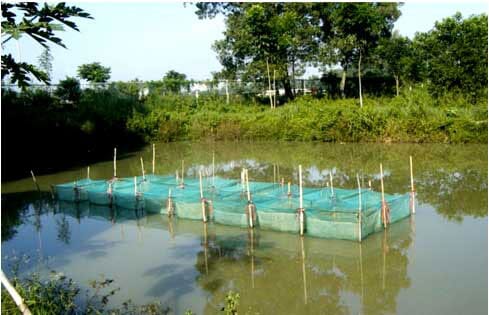
Table 1: Tested Sangrovit® concentrations

The utilized feed was 2 mm extruded floating feed with the following specifications: 30 percent protein, five percent fat, ME min 2,800 Kcal and six percent maximum fibre. Fish were fed to satiation twice a day.
This experiment was conducted in 16 weeks. Fish were weighed every four weeks to monitor growth and survival rates.
At the end of the first experiment, fish were harvested, counted and group weighed to determine final mean weight, FCR and survival rate.
Water quality variables were measured as follow: Dissolved oxygen, temperature and pH were measured twice a day (7 am and 4 pm) using YSI-550 digital oxygen/temperature meter and Fisher-Scientific portable pH meter. Total ammonia nitrogen and nitrite were measured three times a week by spectrometric method. Water in the pond was exchanged regularly to maintain good quality for the entire experimental period. The parameters of the water quality were maintained at the levels shown in the Table 2.
Table 2: Controlled water quality variables

Sampling and analysis
Initially, fish was weighed and randomly distributed into hapa. To minimize the fish not being stressed whilst being weighed, MS222 was used to anaesthetize the fish. At the end of the trial, fish in each hapa were weighed. Growth performances were monitored using specific growth rates (SGR) as follows:
Specific Growth Rate (SGR)

In which:
ð W2 : Mean weight at the end of the experiment
ð W1 : Mean weight at the beginning of the experiment
ð T2- T1 : Duration of the experiment 112 days ( 16 weeks)
Feed efficiency
In the study, feed efficiency was monitored using the feed conversion ratio (FCR) and protein efficiency ratio (PER) as follows
FCR = Total feed intake/ Total weight gain (W2 - W1)
PER = (W2 - W1) / Protein intake
Statistical analyses were performed using Minitab software version 16.0. Data collected from the experiment were analyzed using one-way analysis of variance to determine if significant differences (P<0.05) in final mean weight, FCR, survival rate and non-specific immunity parameters between treatments. Tukey multiple comparison test was utilized to determine differences among treatment means.
Results and discussion
Data presented in Table 3 shows that final mean weight of the first three treatments was not significantly different (P>0.05). However, final mean weight of treatments 3 and 4 was significantly higher than that of the control.
The survival rate of all treatments was not significantly different. The highest SGR was obtained in treatment 3, followed by treatments 4 and 2 and significantly different from the control. It means that Sangrovit® supplemented to the feed at levels from 50-100 g/ton of feed are able to enhance growth rate of tra catfish (Figure 2).
Table 3: Final mean weight, SGR (add ‘SGR’), FCR and survival rate of experimented fish

Figure 2: Impact of Sangrovit® supplementation on the Specific Growth Rate
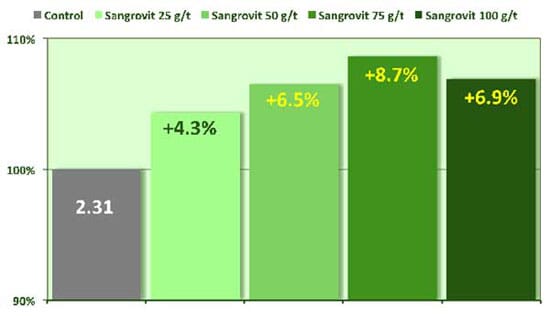
One of the most important parameters to consider in tra catfish farming is FCR. Data from Table 3 showed that FCR of the control treatment was significantly higher than those belonged to treatments 1, 3 and 4. Sangrovit® supplementation to the feed at levels of 75 and 100 g/ton helps to reduce FCR remarkably (Figure 3). That means the Sangrovit® supplementation in P.hypophthalmus feed has improved the feed utilization by enhancing the secretion of internal enzymes in digestive tract.
Figure 3: Impact of Sangrovit® supplementation on the FCR
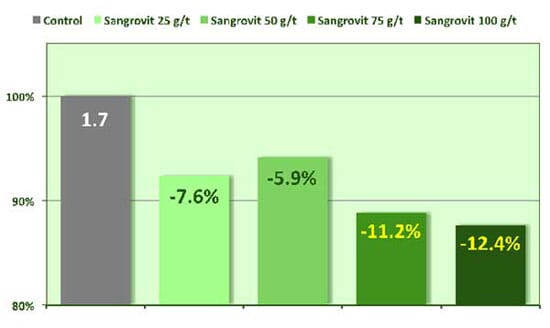
Effect of Sangrovit® on health improvement
After the first experiment was completed, 15 fish from each hapa were randomly assigned to a 100-L fibreglass tank of a wet lab for a challenge test with Edwardsiella ictaluri to evaluate the effects of Sangrovit® on health status of experimented fish.
Lysozyme activity
When the first experiment was completed, five fish from each hapa were challenged by dipping in a low-density Edwardsiella ictaluri solution (1.28 x 105 CFU/mL) for one hour in order to stimulate the activity of immune system.
Blood samples were taken right before challenging, 24 hours and 72 hours after challenging to measure lysozyme activity. Lysozyme activity of all five treatments is presented in Table 4 and Figure 4.
Table 4: Lysozyme activity of experimented fish

Figure 4: Lysozyme activity of experimented fish
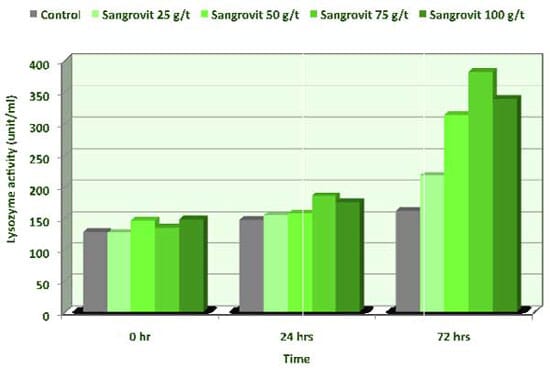
Data in Table 4 and Figure show that serum lysozyme activity of all treatments was not significantly different at 0 hours and 24 hours post challenge with Edwardsiella ictaluri. However, this parameter was significantly higher in treatments 3 and 4 as compared to the control at 72 hours post challenge. The supplementation of Sangrovit® at levels of 75 and 100 g/ton of feed helped to boost immune system of tra catfish through increasing lysozyme activity to a level that significantly different from the control.
White blood cell density
White blood cell density was determined at the same time frame as lysozyme activity measurement and presented in Table 5 and Figure 5.
Table 5: White blood cell density (x103 cell/mm3) of experimented fish

Data are expressed as Mean ± SD. Data with the same superscript in the same row are not significant differences (P>0.05)
Data in Table 5 shows that white blood cell density was not significantly different among treatments at 0 hours, 24 hours and 72 hours post challenge. However, this parameter tended to be higher in Sangrovit® supplemented treatments as compared to the control at 24 hours and 72 hours post challenge. Sangrovit® might enhance the production of white blood cell to fight against infected bacteria.
Figure 5: White blood cell density of experimented fish
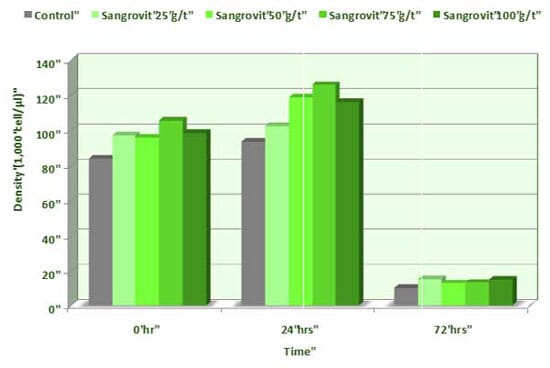
Survival
Experimented fish were dipped in an Edwardsiella ictaluri solution (3.39 x 105 CFU/ml) for 1 hour and then returned to the tank.
Mortalities were monitored for 14 days. During this period, water temperature was maintained at 26 oC, an optimal temperature for bacteria growth. Dead or moribund fish were retrieved from the tanks. They were necropsied, and bacterial laboratory diagnosis was made from the moribund and freshly dead fish.
Bacteria from moribund and freshly dead fish were isolated and classified by IDS 14 GNR test kit of Nam Khoa company.
The results of the second experiment were presented in Table 6 showed that the mortality of tra catfish started from day four and stopped at day 11-post challenge.
Table 6: Survival rate of tra catfish at 14 days post challenge
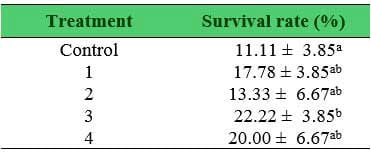
Figure 6: Survival rate of the tra catfish during 14 days
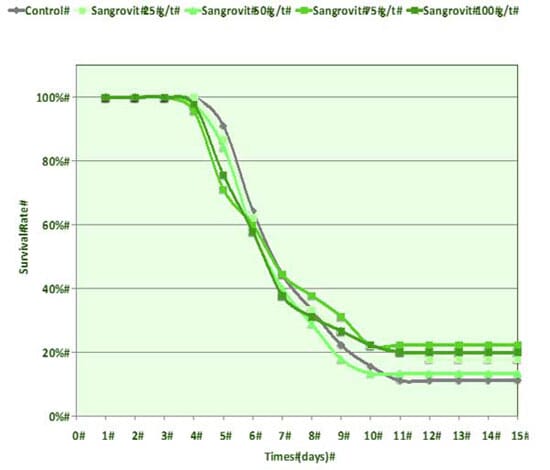
The survival rate of tra catfish in treatment 3 was significantly higher than that of the control. Sangrovit® supplementation at a level of 75 g/ton of feed could enhance survival rate of tra catfish when challenged by Edwardsiella ictaluri.
Conclusions
Notably Sangrovit® inclusion to commercial feed at levels of 75 g/ton enhanced growth rate, SGR and lysozyme activity of Pangasius hypophthalmus, and it also reduced FCR significantly. Further, a positive effect on the test fish challenged with Edwardsiella ictaluri was detected.
The measured influence can be attributed to the known effect on nutrient absorption and on the anti-inflammatory mode of action of Sangrovit®, which is particularly focused on the intestinal tract. Thus feed conversion and digestibility and the health status of fish was improved.
Therefore, Sangrovit® is recommended to be used in the feed at this level to increase return on investment of Pangasius hypophthalmus farming industry.
November 2013




